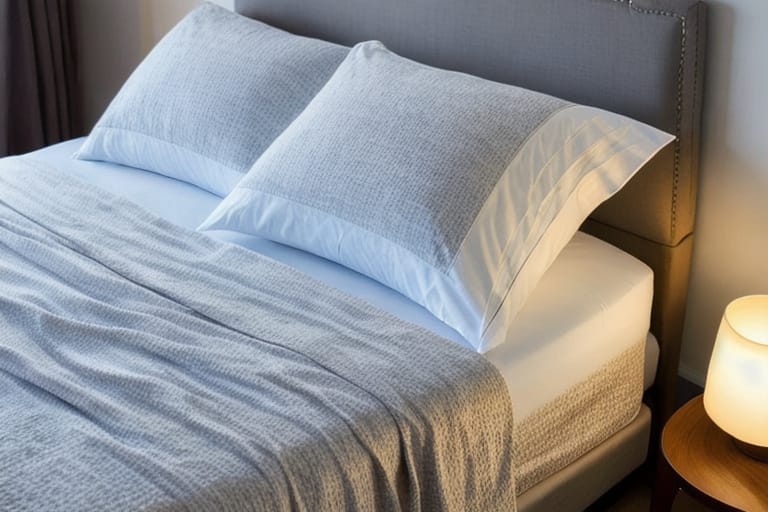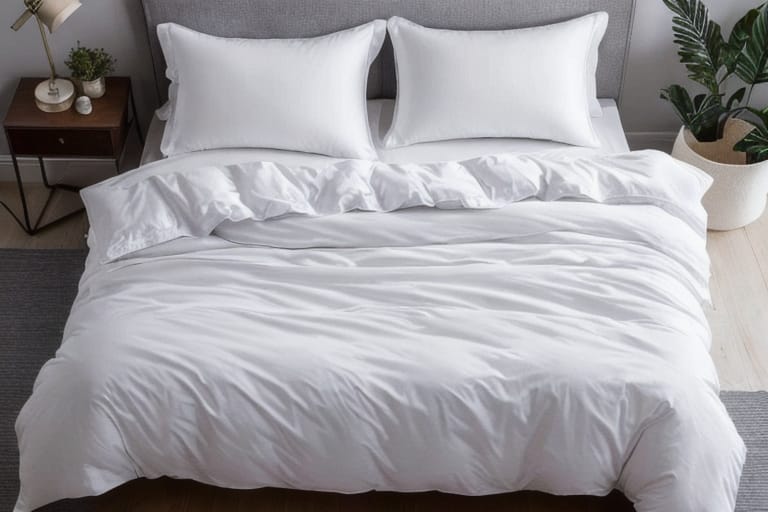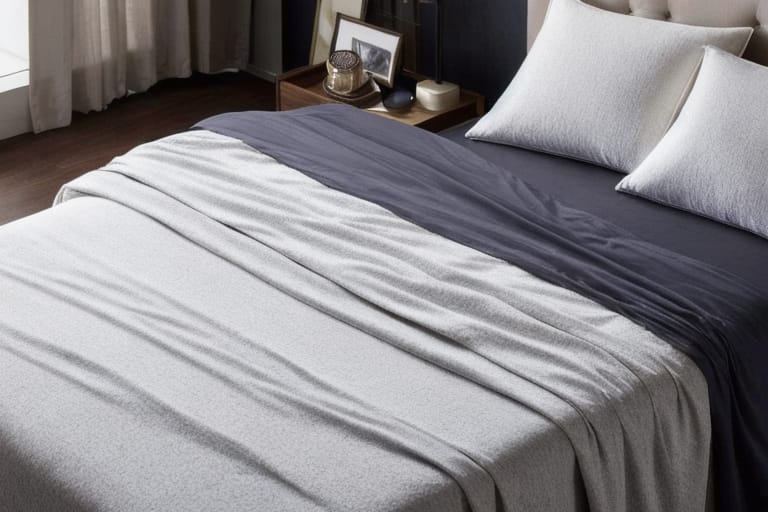When shopping for a plush, cozy down comforter, you may come across terms like “down fill” or “down cluster” listed instead of simply “feathers.” This can lead to confusion about what, exactly, is inside that puffy comforter. Do down comforters have feathers or not?
The answer is not as straightforward as you may think. While some down comforters do contain feathers, others use carefully-sorted down fill without feathers. There are also key differences between duck and goose down that impact quality and performance.
In this beginner’s guide, we’ll look closely at:
- What defines down bedding
- The components of down comforters
- Goose vs. duck down
- Sorting and fill powers
- The role of feathers
- Construction, thread counts, and fabrics
- Pros, cons, care and more!
Gaining a deeper understanding about how down comforters are made will help you select the best one to meet your needs so you can enjoy cozy, cloud-like comfort for years.
A Soft Introduction to Down Bedding
Before we dive into the details on feathers in down comforters, it helps to level-set on what exactly down bedding entails.
Down bedding refers broadly to duvets, comforters, pillows, mattress toppers and other bedding filled with either down or feathers sourced from duck or geese. This includes:
- Down comforters – Quilted bed covers filled with down
- Down pillows – Bed pillows filled with down
- Down toppers – Mattress covers filled with down to enhance comfort
- Down duvets – Removable down-filled covers used over comforters
- Down throws/blankets – Lightweight down blankets for warmth
The “down” in down comforters and bedding refers to the fine, fluffy clusters and plumules that form under the feathers of ducks and geese. This is the warmer, insulating layer closest to the birds’ skin.
In the context of bedding, people often use the terms down and feathers interchangeably. However, they have distinct properties when used in comforters and pillows.
Clearing Up Confusion: Feathers vs. Down
While some lump feathers and down together as one and the same, they have a few notable differences:
Feathers provide structure, thickness and support to down bedding. They have quills that can poke through fabric.
Down offers softness, compressibility and unmatched warmth without weight. It lacks quills and adds loft. The finest down clusters are light and fluffy.
With pure down fill, manufacturers remove all feathers and use only the warm, wispy down clusters. They may also blend down with small, chopped feathers to add some structure.
Bedding filled solely with feathers lacks the same cloud-like comfort. It feels heavier, doesn’t compress as easily, and doesn’t insulate quite as well ounce for ounce.
Now that we’ve clarified the distinction between feathers and down, let’s explore types of down comforters in greater depth.
Down, Down Alternative or Blend Comforters
When you start shopping for a down comforter, you’ll encounter down, down alternative, or down blended options:
1. Down comforters use pure down or a down fill and feather blend as insulation. High-end versions use finer “ultraloft” down with higher fill powers and no feathers.
2. Down alternative comforters skip feathers and down entirely. Instead, they use synthetic fills like PrimaLoft to mimic the qualities of down at lower price points.
3. Down blended comforters combine real down and feathers with synthetic fills. This lets manufacturers use less down to lower costs while benefiting from some natural down properties.
With down and feather terminology clarified, let’s see what goes inside genuine down comforters.
Inside a Down Comforter: Materials and Construction
Beyond the type of fill, several components work together to make a cozy down comforter
- Shell/outer fabric – Usually a lightweight, breathable fabric like cotton, cotton sateen or silk
- Fill – Down and/or feathers held inside baffled channels
- Baffles – Fabric dividers that distribute fill evenly across the comforter
- Piping – Outlines each baffle section
- Corner loops – Attach a duvet cover over the comforter
Manufacturers first sew together an outer shell from fabric. They divide up sections inside using baffles secured by piping along the seams. Filling each baffled channel with down distributes it evenly across the comforter. Corner loops allow you to attach a protective duvet cover.
With premium down comforters, precise construction ensures maximum loft, fill consistency and durability. Now let’s explore fill powers and thread counts that impact quality.
Comforter Qualities: Fill Power and Thread Count
Aside from materials, two key specs to examine with down comforters are:
*Fill power – The loft and fluffiness of the down fill measured in cubic inches per ounce. Higher numbers mean more insulation value.
- **Thread count ** – The number of threads woven together in a square inch of shell fabric. Higher thread counts usually indicate softer, more durable fabric.
Fill Power and Performance
As mentioned, fill power designates loft and warmth. Down used in comforters gets sorted by cluster size and quality into different fill powers:
The highest quality goose down yields fill powers between 600-900. Ultra-premium comforters use 800-900+ fill power down for maximum loft and insulation.
By removing larger feathers and debris, higher fill power down offers:
- Increased fluffiness and loft
- Enhanced compressibility
- Greater warmth for the weight
- Longer durability over years of use
With lower fill powers, more feathers and impurities get mixed in with down clusters. This adds weight and reduces insulation value.
Thread Count for Strength and Comfort
Thread count signifies the number of horizontal and vertical threads per square inch in the outer fabric. Low thread counts under 200 can feel stiff and wear out faster. High-end comforters use 300 thread count cotton sateen or 400-500 thread count silk:
Benefits of higher thread counts include:
- Softer, more flexible fabric
- Enhanced durability over years of use
- Improved down proofing to prevent fill loss
- More consistent, smaller quilting boxes to prevent shifting
Now that we’ve reviewed fill powers and thread counts, let’s compare the pros and cons of goose versus duck down.
Goose Down vs. Duck Down: Key Differences
The two main types of down used in comforters come from geese and ducks. They have a few important distinctions:
Goose down comes from mature geese during molting season. The large clusters provide exceptional loft and durability. However, goose down demands a higher price.
Duck down gets harvested from ducks raised for meat production. The smaller clusters are not quite as lofty or resilient. But duck down costs significantly less than goose.
Here’s how they compare:
In most cases, goose down fills higher-end comforters, pillows and bedding. Manufacturers reserve duck down for lower price points.
A few boutique European brands like Hungarian Feather & Down Co. use special white goose down. But the vast majority source goose down from China, typically Shandong province.
Now that we’ve explored the critical components that make up down comforters, let’s recap whether they contain feathers or not.

The Role of Feathers in Down Comforters
As we’ve learned, down and feathers have distinct properties. Top-tier comforters skip feathers entirely and only utilize pure, high fill power goose down for maximum loft.
However, more affordable down comforters use a deliberate down and feather blend to cut costs. Blending chops, scraps and smaller feathers in with down lets brands stretch the down further and achieve a target fill weight.
Lower fill powers also leave in more feathers. Sorting out impurities becomes less rigorous to save time and money. While feathers add structure, they have quills that may poke through the shell.
Finally, down alternative comforters constructed from polyester or rayon skip feathers and down altogether. Instead, the focus stays on mimicking the qualities of down through synthetic fills.
So in summary:
- High-end down comforters use pure, ultra-fine goose down with no feathers
- Mid-range down-blend comforters mix feathers in with down to reduce cost
- Down alternative comforters rely solely on synthetic fills to emulate down properties
Now that we’ve answered whether down comforters have feathers, let’s compare the pros, cons, costs and care considerations.
Down Comforter Benefits, Drawbacks and Cleaning
Deciding between down, down blend or down alternative comforters depends on your priorities. Here’s how they compare across some key factors:
A few key takeaways:
- Pure down provides the ultimate in luxury and durability but commands premium pricing
- Down and feather blends offer a solid balance of comfort and value
- Down alternatives give excellent budget-friendly performance and easier care
Regardless of fill type, protect your investment with a duvet cover changed/washed more regularly than the comforter itself.
For cleaning guidance, reference manufacturer directions. Typically it’s best to dry clean down comforters every 2-3 years. Spot clean stains when needed.
Now let’s turn our attention to down’s warming capabilities and breathability.
Why Down Insulates So Well: Trapped Air
Beyond fluffy comfort, down makes such an exceptional insulator thanks to its unique structure. Those tiny down clusters trap thousands of micro air pockets between connecting filaments and branches:
This forms a breathable layer of trapped, non-moving air. Heat gets contained inside while allowing water vapor to pass through. Since trapped air doesn’t conduct ambient temperatures well, down provides top-tier insulation.
The highest fill power down with the most filaments and surface area generates superior trapped air and warmth. Even the slightest breeze collapses those air bubbles, forcing birds to fluff up their feathers for insulation.
(For even nerdier birds and physics fans, down structures provide resistance to conductive, convective AND radiative heat transfer!)
While down traps air incredibly well, does it have any downsides (pun intended?) Let’s discuss some potential drawbacks.
Downsides and Considerations for Down Comforters
As with most products, down comforters come with a few tradeoffs. Be aware of these factors before choosing one:
Odor retention – Natural oils can make down retain smells more easily over years of use.
Allergies – Trace dander in down can aggravate allergies. Hypoallergenic alternatives may work better for sensitivity.
Mildew concerns – Improper drying after washing risks mold growth in down that’s difficult to remove.
Prone to clumping – Down requires regular fluffing to prevent cold spots from fill shifting and clumping.
Costly cleaning – Professional laundering is ideal but adds expense every few years.
Not vegan – Sourcing down involves animals so it does not align with vegan morals.
While mostly minimal drawbacks for many shoppers, weigh your priorities before deciding on a down comforter.
Next let’s compare options for responsibly and ethically sourced down.
Responsible Down: Animal Welfare Considerations
An important concern for conscientious consumers involves the humane treatment of geese and ducks during down harvesting.
Two organizations work to ensure responsible down production standards:
The Responsible Down Standard (RDS) audits and certifies companies that practice animal welfare and traceability measures. Brands like Patagonia, Eddie Bauer and others use RDS-certified down.
Meanwhile, the Global Traceable Down Standard from NSF International provides similar assurance through independent auditing. Brands like Cuddledown and Snowe use GTDS-approved down.
Searching for RDS or GTDS certifications helps promote sustainable sourcing practices. Another option? Alternatives to animal-based down bedding.
Down Alternative Comforters: Synthetic Fills
For shoppers looking to avoid animal products, several synthetic alternatives mimic luxury down properties without feathers:
PrimaLoft
One of the most popular is PrimaLoft. Initially designed to insulate military uniforms, many bedding brands now utilize this premium synthetic fill.
Made from extra-fine microfibers, PrimaLoft offers excellent thermal efficiency. It looks and feels similar to high-quality goose down yet costs less. It also outperforms lower grades of duck down.
Rayon (Viscose) from Bamboo
Another intriguing emerging option involves rayon fiber made of bamboo. It often gets marketed as “eco friendly” and a down alternative.
The comfort remains similar to PrimaLoft. But while bamboo rayon does come from renewable bamboo stocks, some question the sustainability claims given the chemical processing methods.
Polyester
Many basic down alternative comforters stuff polyester fills inside the quilted channels instead of down. However, cheaper grades of polyester don’t tend breathe as well or last as long as PrimaLoft or bamboo rayon.
For shoppers with textile-related allergies, sensitive skin, strict vegan diets or ethical concerns over animal products, down alternative comforters eliminate feathers and down while remaining competitively priced.
Now that we’ve covered the wide range of down bedding options, let’s summarize the key takeaways from this guide.

Conclusion: Considerations for Cozy Comfort
To wrap things up:
Q: Do all down comforters contain feathers?
A: Not necessarily. High-end pure down comforters use no feathers. But many affordable down comforters do blend feathers in with down to reduce cost and add structure.
Beyond feathers vs no feathers, focus first on factors like:
- Fill power – Prioritize 600+ fill power down (or 80+ ounce fill weights)
- Fabric thread count 300+ for strength and softness
- Responsible sourcing through certification programs
- Care requirements – Professional cleaning every few years
- Budget – Prices run the gamut from budget to luxury
Finding your optimal balance of quality, comfort and value requires checking the fine print labels and details of any down comforter. But doing so lets you enjoy blissfully peaceful nights.
Frequently Asked Questions
1. Is goose or duck down better for down comforters?
Goose down is generally considered higher quality and more durable. The larger clusters provide better insulation and loft compared to smaller duck down clusters. Geese down tends to last longer over years of use retaining fluffiness. However, goose down has a higher price point given short global supply. Many premium comforters use a down fill consisting 100% of goose down for maximum coziness and long-term performance.
2. How often should you wash a down comforter?
Most experts recommend dry cleaning down comforters once every 2-3 years to revitalize and sanitize the down fill. However, always defer to the manufacturer’s care instructions listed on the attached tag label. For stains or spills in between professional cleaning cycles, spot clean the outer shell fabric carefully using a gentle cleaner safe for down. Stuff the comforter loosely into a large commercial washer without overfilling and use a gentle detergent to clean in cold water. Make sure to completely air dry the down comforter to prevent potential mildew.
3. Can you put down comforters in the dryer?
No, you should always air dry down comforters naturally rather than machine dry, even on a low or no heat cycle. Exposing down to excess mechanical heat and friction risks damaging cluster filaments and reducing loft. A commercial size washer on a gentle cycle can wash down comforters followed by air drying. Ensure down fills dry fully over 24-48 hours before use or storage to prevent moisture accumulation. For optimal results, dry clean down comforters every few years and spot treat stains rather than frequently machine washing.
4. What is down fill power?
As measured in cubic inches per ounce, fill power categorizes the loft, fluffiness and associated insulating value of various down cluster grades sorted by size. The finest, highest fill powers typically come from mature geese. Premium goose down comforters utilize fill powers between 600-900+ for maximum loft and efficient warmth retention. Higher fill powers generally last longer retaining loft over years depending on usage. Lower fill power down contains more feather bits, debris and quill stems that reduce comfort and compressibility.
5. Do down alternative comforters keep you as warm?
The best down alternative comforters using siliconized fiberfills like PrimaLoft or rayon from bamboo mimic high fill power down quite well. But cheaper polyester fibers lack breathability. Premium synthetic fills trap heat nearly on par with quality goose down below 600 fill power. Improved microfiber technology continually narrows the performance gap with down. The top down alternative comforters provide excellent comfort and value. However, ultra-high fill power goose down continues to offer maximum durable insulation pound for pound.








